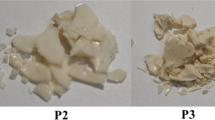Abstract
Since the early 1970s, it has been known that exposure of poly(caprolactone) (PCL) to a variety of microorganisms results in biodegradation of this polymer. Besides the ability of PCL to be utilized as a carbon source for microorganisms, it has been demonstrated that, during degradation, carbon dioxide is generated. Soil burial and compost experiments have shown that chain scission of the PCL backbone occurs, mechanical properties of articles prepared from PCL are reduced rapidly, and significant weight loss occurs in a short time period. This inherent biodegradability of PCL, in combination with its ability to be converted by conventional extrusion equipment, allows for the preparation of biodegradable articles that have utility.
Similar content being viewed by others
References
J. E. Potts, R. A. Clendinning, and W. B. Ackart (1972)An Investigation of the Biodegradability of Packaging Plastics. Office of Research and Monitoring. U.S Environmental Protection Agency, Washington, DC, Rep. EPA-R2-72-046, pp. 22–24.
W. J. Bailey, V. K. Kuruganti, and J. S. Angle (1990) in J. E. Glass and G. Swift (Eds.),Agriculture and Synthetic Polymers, Biodegradability and Utilization, ACS Symposium Series 433, Am. Chem. Soc., Washington, DC, pp. 149–160.
D. Goldberg and R. F. Eaton (1991) in Nonwovens Business Conference, Insight 91, Charleston SC, pp. V1–V10.
C. V. Benedictet al. (1983)J. Appl. Polym. Sci. 28 327–334.
C. V. Benedict, J. A. Cameron, and S. J. Huang (1983)J. Appl. Polym. Sic. 28 335–342.
P. Jarrett, C. V. Benedict, J. P. Bell, J. A. Cameron, and S. J. Huang (1985) in S. Shalabyet al., (Eds.),Polymers as Biomaterials, Plenum Press, New York, pp. 181–192.
Y. Tokiwa, T. Ando, T. Suzuki, and K. Takeda (1990) in J. E. Glass and G. Swift (Eds.),Agriculture and Synthetic Polymers, Biodegradability and Utilization, ACS Symposium Series 433, Am. Chem. Soc., Washington, DC, pp. 136–148.
R. D. Fields, F. Rodriguez, and R. K. Finn (1974)J. Appl. Polym. Sci. 18 3571–3579.
D. Goldberg, R. F. Eaton, and J. F. Rocky (1991)Inda J.,3 36–40.
Author information
Authors and Affiliations
Rights and permissions
About this article
Cite this article
Goldberg, D. A review of the biodegradability and utility of poly(caprolactone). J Environ Polym Degr 3, 61–67 (1995). https://doi.org/10.1007/BF02067481
Issue Date:
DOI: https://doi.org/10.1007/BF02067481




